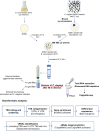Identification of Burkholderia cenocepacia non-coding RNAs expressed during Caenorhabditis elegans infection
- PMID: 37097504
- PMCID: PMC10175445
- DOI: 10.1007/s00253-023-12530-3
Identification of Burkholderia cenocepacia non-coding RNAs expressed during Caenorhabditis elegans infection
Abstract
Small non-coding RNAs (sRNAs) are key regulators of post-transcriptional gene expression in bacteria. Despite the identification of hundreds of bacterial sRNAs, their roles on bacterial physiology and virulence remain largely unknown, as is the case of bacteria of the Burkholderia cepacia complex (Bcc). Bcc is a group of opportunistic pathogens with relatively large genomes that can cause lethal lung infections amongst cystic fibrosis (CF) patients. To characterise sRNAs expressed by Bcc bacteria when infecting a host, the nematode Caenorhabditis elegans was used as an infection model by the epidemic CF strain B. cenocepacia J2315. A total of 108 new and 31 previously described sRNAs with a predicted Rho independent terminator were identified, most of them located on chromosome 1. RIT11b, a sRNA downregulated under C. elegans infection conditions, was shown to directly affect B. cenocepacia virulence, biofilm formation, and swimming motility. RIT11b overexpression reduced the expression of the direct targets dusA and pyrC, involved in biofilm formation, epithelial cell adherence, and chronic infections in other organisms. The in vitro direct interaction of RIT11b with the dusA and pyrC messengers was demonstrated by electrophoretic mobility shift assays. To the best of our knowledge this is the first report on the functional characterization of a sRNA directly involved in B. cenocepacia virulence. KEY POINTS: • 139 sRNAs expressed by B. cenocepacia during C. elegans infection were identified • The sRNA RIT11b affects B. cenocepacia virulence, biofilm formation, and motility • RIT11b directly binds to and regulates dusA and pyrC mRNAs.
Keywords: Burkholderia cenocepacia; C. elegans infection model; Non-coding RNAs; RNA-seq.
© 2023. The Author(s).
Conflict of interest statement
The authors declare no competing interests.
Figures





Similar articles
-
Non-coding regulatory sRNAs from bacteria of the Burkholderia cepacia complex.Appl Microbiol Biotechnol. 2024 Apr 2;108(1):280. doi: 10.1007/s00253-024-13121-6. Appl Microbiol Biotechnol. 2024. PMID: 38563885 Free PMC article. Review.
-
The hfq gene is required for stress resistance and full virulence of Burkholderia cepacia to the nematode Caenorhabditis elegans.Microbiology (Reading). 2010 Mar;156(Pt 3):896-908. doi: 10.1099/mic.0.035139-0. Epub 2009 Nov 26. Microbiology (Reading). 2010. PMID: 19942656
-
The Burkholderia cenocepacia Type VI Secretion System Effector TecA Is a Virulence Factor in Mouse Models of Lung Infection.mBio. 2021 Oct 26;12(5):e0209821. doi: 10.1128/mBio.02098-21. Epub 2021 Sep 28. mBio. 2021. PMID: 34579569 Free PMC article.
-
Burkholderia cenocepacia in cystic fibrosis: epidemiology and molecular mechanisms of virulence.Clin Microbiol Infect. 2010 Jul;16(7):821-30. doi: 10.1111/j.1469-0691.2010.03237.x. Clin Microbiol Infect. 2010. PMID: 20880411 Review.
-
Comparative Genomics and Evolutionary Analysis of RNA-Binding Proteins of Burkholderia cenocepacia J2315 and Other Members of the B. cepacia Complex.Genes (Basel). 2020 Feb 21;11(2):231. doi: 10.3390/genes11020231. Genes (Basel). 2020. PMID: 32098200 Free PMC article.
Cited by
-
Non-coding regulatory sRNAs from bacteria of the Burkholderia cepacia complex.Appl Microbiol Biotechnol. 2024 Apr 2;108(1):280. doi: 10.1007/s00253-024-13121-6. Appl Microbiol Biotechnol. 2024. PMID: 38563885 Free PMC article. Review.
References
-
- Bu D, Luo H, Huo P, Wang Z, Zhang S, He Z, Wu Y, Zhao L, Liu J, Guo J, Fang S, Cao W, Yi L, Zhao Y, Kong L. KOBAS-i: intelligent prioritization and exploratory visualization of biological functions for gene enrichment analysis. Nucleic Acids Res. 2021;49:W317–W325. doi: 10.1093/nar/gkab447. - DOI - PMC - PubMed
MeSH terms
Substances
Grants and funding
LinkOut - more resources
Full Text Sources

